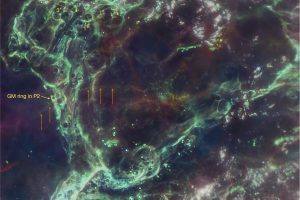A green monster inside Cas A unveils the secrets of its violent phenomena. The study: “The Green Monster Hiding in Front of Cas A: JWST Reveals a Dense and Dusty Circumstellar Structure Pockmarked by Ejecta Interactions” of I. de Looze (Ghent University) recently appeared on ApJL

There are many lessons about the physics of supernova remnants and progenitor stars that the Cassiopeia A (Cas A) supernova remnant teaches us. For example, we have learned that both the supernova explosion and the mass-loss episodes that characterize the final evolutionary stages of the progenitor star can be highly asymmetric. We have come to understand that supernovae can play an important role in the production of the dust that populates the Universe and in the acceleration of cosmic rays, and we have learned many aspects of the complex interaction between the circumstellar material expelled by the progenitor, the preexisting interstellar material, and the shock waves generated within the supernova.
In fact, every new telescope that has observed Cas A has revealed another piece of its history and the physical processes governing it. The super-telescope built by the American (NASA) and European (ESA) space agencies, the James Webb Space Telescope (JWST), is no exception. Its extraordinary images of Cas A have revealed important details about the physico-chemical properties of the circumstellar material impacted by the shock waves. The most astonishing of these structures is certainly the “Green Monster,” a structure that dominates the central part of the supernova remnant, so named because of the obvious green coloration it assumes in the false-color image obtained by combining JWST observations. The measurements of the chemical composition of the Green Monster, made possible by these observations, confirm that this structure is composed of layers of circumstellar material produced by mass-loss episodes of the progenitor, which occurred asymmetrically.
A peculiar feature of the Green Monster, observable in JWST images, is the presence of a series of “holes” with physical sizes of several thousand astronomical units (1 AU corresponds to 150 million km, which is the average distance between the Earth and the Sun). The explanation for this curious morphology is provided by a model published in 2022 and developed by the team led by S. Orlando, a researcher at INAF – Osservatorio Astronomico di Palermo. According to the model and the analysis of the JWST observations, the circumstellar material that constitutes the Green Monster is impacted by fragments of the exploded star (ejecta), rich in nitrogen and moving at speeds between 8000 and 10500 km/s. The holes observed in the Green Monster would be the direct result of this interaction, which is thought to have occurred before the Green Monster was hit by the shock wave produced by the supernova, which propagates within Cas A at a speed of 5000–6000 km/s.
The study is described in the article “The Green Monster Hiding in Front of Cas A: JWST Reveals a Dense and Dusty Circumstellar Structure Pockmarked by Ejecta Interactions” by I. De Looze (Sterrenkundig Observatorium, Ghent University), recently published in The Astrophysical Journal Letters. Among the authors is also S. Orlando, who carried out the simulations that helped to understand the nature of the peculiar morphology of the Green Monster.
The cover image (click here to view it in full) shows a detail of the Green Monster, with several “holes” clearly visible whose angular sizes range from 1 to 3 arcsec.
Mario Giuseppe Guarcello
Follow MarioSpiegaCose on Instagram () , Facebook (), Youtube (), and X ()
Follow the Astronomical Observatory of Palermo on Facebok and on Instagram
Subscribe the Youtube channel of the Astronomical Observatory of Palermo
